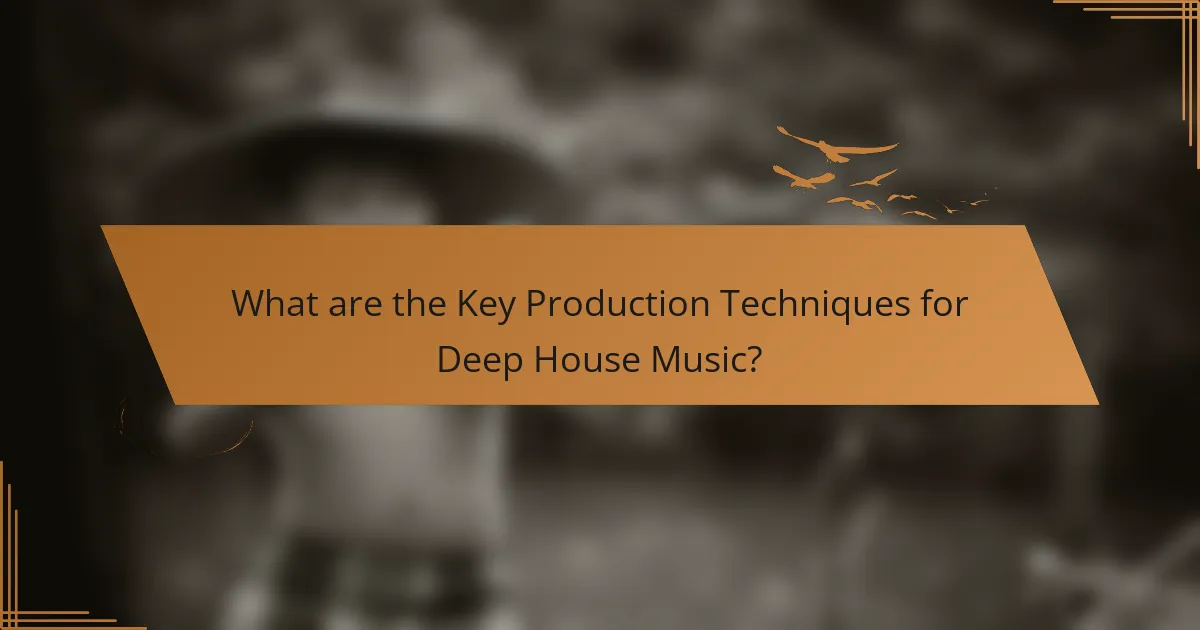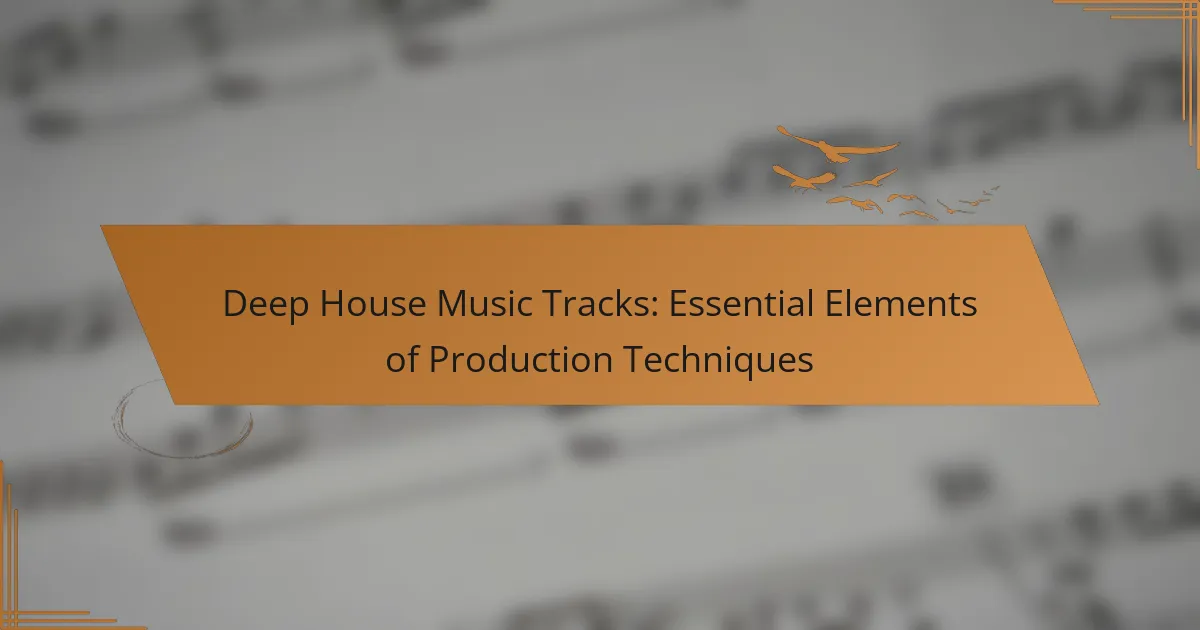Deep house music is characterized by a steady four-on-the-floor beat, smooth basslines, and atmospheric pads, typically set at a tempo between 120 and 125 BPM. Key production techniques include layering, sampling, and sound design, which enhance the richness and depth of tracks. Current trends in deep house production feature the incorporation of organic sounds, innovative sampling, and the use of AI tools for music composition. Additionally, the rise of immersive audio formats and collaborations with software developers for tailored plugins are shaping the genre, while the resurgence of vinyl and analog equipment appeals to listeners seeking authenticity. This article provides a comprehensive overview of the essential elements and production techniques that define deep house music.

What are the Essential Elements of Deep House Music Tracks?
Deep house music tracks typically include a steady four-on-the-floor beat, smooth basslines, and atmospheric pads. The four-on-the-floor beat provides a consistent rhythm, commonly set at a tempo between 120 and 125 BPM. Smooth basslines are often characterized by deep, warm tones that create a groovy foundation. Atmospheric pads add a layer of depth, often featuring lush chords and ambient sounds. Vocals in deep house tracks are usually minimal and often processed with effects to enhance the overall vibe. Additionally, the use of samples from jazz, soul, or funk genres is common, contributing to the genre’s rich sound. These elements together create the signature feel of deep house music, appealing to both dancers and listeners.
How do the foundational elements shape Deep House Music?
The foundational elements shape Deep House Music by establishing its signature sound and emotional depth. Key elements include a steady four-on-the-floor beat, which creates a consistent rhythm. Deep basslines contribute to the genre’s rich texture and groove. Chord progressions often feature jazzy or soulful influences, enhancing the emotional resonance. Vocals, when present, are typically smooth and often ethereal, adding to the atmospheric quality. The use of ambient sounds creates a spacious feel, allowing listeners to immerse themselves. Production techniques like reverb and delay further enhance the depth and complexity of the sound. These elements collectively define Deep House Music and distinguish it from other electronic genres.
What role do rhythm and tempo play in Deep House production?
Rhythm and tempo are fundamental components in Deep House production. Rhythm establishes the groove and feel of the track. It influences how listeners engage with the music. Tempo, typically ranging from 120 to 125 BPM, creates a relaxed yet danceable pace. This balance allows for smooth transitions and layered melodies. The interplay between rhythm and tempo enhances the emotional depth of the track. Effective use of syncopation in rhythm adds complexity and intrigue. Together, they shape the overall atmosphere of Deep House music.
How do basslines contribute to the overall sound of Deep House tracks?
Basslines are fundamental to the overall sound of Deep House tracks. They provide rhythmic foundation and groove, which are essential for danceability. The basslines are often deep and rich, creating a warm atmosphere. This depth enhances the emotional impact of the music. Additionally, basslines interact with other elements, such as drums and synths, to create a cohesive sound. They often utilize syncopated rhythms, which add complexity and interest. The use of sub-bass frequencies is common, allowing the bass to resonate in club settings. Overall, basslines are crucial in defining the unique character of Deep House music.
What are the typical instruments used in Deep House Music production?
Deep House Music production typically uses synthesizers, drum machines, and samplers. Synthesizers create lush pads and basslines, essential for the genre’s sound. Drum machines provide the rhythmic backbone with deep kicks and crisp snares. Samplers are used to incorporate vocal snippets and atmospheric sounds. Additionally, effects processors enhance the overall texture of the music. Common synthesizers include the Roland Juno and Moog Sub 37. Popular drum machines include the Roland TR-808 and TR-909. These instruments contribute to the genre’s signature deep and soulful vibe.
How do synthesizers and samplers enhance the Deep House sound?
Synthesizers and samplers enhance the Deep House sound by providing rich textures and layered sounds. Synthesizers create deep bass lines and atmospheric pads characteristic of the genre. These elements contribute to the overall groove and rhythm essential in Deep House music. Samplers allow producers to incorporate diverse sounds and vocal snippets, adding unique elements to tracks. This results in a more dynamic listening experience. The use of both tools enables the creation of complex sonic landscapes. This complexity is a hallmark of Deep House, appealing to listeners and dancers alike. The combination of synthesized sounds and sampled elements shapes the genre’s distinctive identity.
What is the significance of vocal samples in Deep House tracks?
Vocal samples in Deep House tracks are significant for enhancing emotional depth and creating atmosphere. They add a human touch to the music, making it more relatable. These samples often evoke feelings of nostalgia or intimacy. Additionally, vocal samples can serve as hooks, capturing listeners’ attention. They contribute to the overall texture and layering of the track. The use of chopped or manipulated vocals can create unique rhythmic patterns. This technique is prevalent in Deep House, showcasing the genre’s creativity. Overall, vocal samples are crucial for defining the sound and mood of Deep House music.
Why is sound design crucial in creating Deep House Music?
Sound design is crucial in creating Deep House Music because it shapes the overall atmosphere and emotional impact of the tracks. Unique sound textures contribute to the genre’s signature depth and warmth. Layering sounds enhances the immersive quality that listeners expect. The use of synthesizers and effects creates rich, evolving soundscapes. Specific techniques like filtering and modulation add movement and dynamism to the music. Effective sound design helps distinguish tracks in a competitive market. It also plays a role in defining the groove, which is essential for danceability. Ultimately, high-quality sound design elevates the listening experience, making it memorable and engaging.
What techniques are commonly used in sound design for Deep House?
Common techniques used in sound design for Deep House include sampling, layering, and modulation. Sampling involves using pre-recorded sounds to create unique textures. Layering combines multiple sounds to enrich the overall sonic palette. Modulation alters sound parameters over time, adding movement and depth. Additionally, sidechain compression is frequently applied to create rhythmic pumping effects. Reverb and delay are also essential for establishing space and ambiance in tracks. These techniques contribute to the distinctive, immersive quality of Deep House music.
How does layering affect the depth of a Deep House track?
Layering enhances the depth of a Deep House track by adding multiple sound elements simultaneously. This technique creates a richer, fuller sound. Each layer can introduce different frequencies and textures. For instance, combining basslines, pads, and melodic elements increases sonic complexity. The interaction between these layers contributes to a more immersive listening experience. Additionally, layering can help establish a sense of space and atmosphere in the track. Producers often use this method to build tension and emotional depth. The result is a dynamic sound that engages listeners on multiple levels.

What are the Key Production Techniques for Deep House Music?
Key production techniques for deep house music include layering, sampling, and sound design. Layering involves combining multiple sounds to create a fuller texture. This technique enhances depth and richness in tracks. Sampling is crucial for incorporating elements from other genres or tracks. It adds unique characteristics and influences to deep house music. Sound design focuses on creating original sounds using synthesizers and effects. This technique shapes the sonic identity of a track. Additionally, using groove and swing helps to create a more human feel in rhythms. EQ and compression are essential for balancing frequencies and dynamics. These techniques ensure clarity and punch in the final mix.
How do mixing and mastering influence the final output of Deep House tracks?
Mixing and mastering significantly influence the final output of Deep House tracks. Mixing involves balancing individual track elements, such as vocals, basslines, and synths. This process ensures clarity and cohesion in the overall sound. Mastering, on the other hand, is the final step that prepares the mixed track for distribution. It involves optimizing the track’s loudness, equalization, and compression.
A well-executed mix enhances the emotional impact of the track. It allows each element to be heard clearly, which is crucial in Deep House music, where intricate layers are common. Mastering ensures that the track sounds polished and consistent across different playback systems.
Research indicates that tracks with professional mixing and mastering can achieve a 10-20% increase in listener engagement. This statistic underscores the importance of these processes in creating a commercially viable Deep House track.
What are the best practices for mixing Deep House Music?
The best practices for mixing Deep House Music include balancing elements, using EQ effectively, and applying compression. Balancing elements ensures that each sound is audible without overpowering others. This creates a cohesive mix that maintains clarity. Using EQ allows for carving out space in the frequency spectrum. It helps to eliminate muddiness and enhances the overall sound. Compression controls the dynamic range of individual tracks. This technique ensures that quieter sounds are heard while preventing peaks from distorting. Additionally, utilizing reverb and delay can add depth and space to the mix. Properly applying these effects enhances the atmospheric qualities of Deep House Music. Finally, referencing professional tracks helps to guide the mixing process. This practice ensures that the mix translates well across different playback systems.
How does mastering differ for Deep House compared to other genres?
Mastering for Deep House differs primarily in its emphasis on low-end frequencies and dynamic range. Deep House tracks typically feature a strong bass presence, requiring careful attention during mastering to maintain clarity without overwhelming other elements. The genre often utilizes extended frequency ranges, which necessitates precise equalization techniques to enhance warmth and depth. Additionally, the overall loudness levels in Deep House are generally lower compared to genres like EDM or pop, as the focus is on groove and atmosphere rather than sheer volume. This approach results in a more dynamic and less compressed final product, allowing for a more organic sound. The use of reverb and delay is also more pronounced in Deep House, influencing the mastering process to ensure these effects blend seamlessly with the mix.
What role does arrangement play in Deep House Music production?
Arrangement plays a crucial role in Deep House Music production. It determines the structure and flow of a track. A well-crafted arrangement enhances the listener’s experience. It typically includes sections like intro, verse, chorus, and breakdowns. Each section serves a specific purpose in building energy and emotion. For instance, the intro sets the mood, while breakdowns create tension. Effective arrangement maintains listener engagement throughout the track. According to music production experts, arrangement can significantly impact a track’s success in the market.
How do transitions enhance the flow of a Deep House track?
Transitions enhance the flow of a Deep House track by creating seamless connections between different sections. They help maintain listener engagement by preventing abrupt changes. Smooth transitions facilitate a natural progression in energy and mood. Techniques like fades, filters, and effects are commonly used. These techniques ensure that the track evolves gradually. Transitions can also build anticipation for upcoming elements. They guide the listener through the musical landscape. Ultimately, effective transitions contribute to the overall coherence of the track.
What are common structures used in Deep House arrangements?
Common structures used in Deep House arrangements include the intro, breakdown, build-up, drop, and outro. The intro typically sets the mood with atmospheric sounds and a steady beat. The breakdown introduces melodic elements and creates tension. The build-up escalates the energy, often incorporating rising synths or percussion. The drop delivers the main groove and hook, where the bassline and drums come to the forefront. Finally, the outro gradually fades out, allowing for a smooth transition to the next track. These structural elements are essential in creating the immersive experience characteristic of Deep House music.
How can producers effectively use effects in Deep House Music?
Producers can effectively use effects in Deep House Music by incorporating reverb, delay, and modulation techniques. Reverb adds depth and space to sounds, creating an immersive atmosphere. Delay can enhance rhythm and create a sense of movement within the track. Modulation effects, such as chorus and flanger, can add richness and complexity to synths and pads.
Using these effects strategically helps maintain the genre’s characteristic groove and vibe. For example, applying reverb on vocal samples can make them feel more integrated within the mix. Similarly, using delay on percussion elements can create a more dynamic rhythm.
Research indicates that the use of effects can significantly impact listener engagement in electronic music. A study by the University of California found that well-placed effects enhance emotional responses to music. This supports the idea that effects are essential tools in Deep House production.
What types of effects are most beneficial for Deep House tracks?
Reverb, delay, and filtering effects are most beneficial for Deep House tracks. Reverb adds depth and space, creating an immersive listening experience. Delay enhances rhythmic elements, providing a sense of movement. Filtering allows for dynamic changes, emphasizing different frequencies throughout the track. These effects contribute to the genre’s signature atmospheric sound. Studies show that effective use of these effects can elevate the overall production quality.
How do reverb and delay contribute to the atmosphere of Deep House music?
Reverb and delay significantly enhance the atmosphere of Deep House music. Reverb creates a sense of space and depth, making sounds feel more immersive. It mimics the natural reflections of sound in various environments. This effect helps to establish an emotional connection with listeners. Delay adds rhythmic complexity and texture to the music. It creates echoes that can fill gaps and maintain listener engagement. Together, reverb and delay contribute to the genre’s signature smooth and atmospheric sound. These effects allow for a more dynamic listening experience, essential in Deep House tracks.

What are the Trends and Innovations in Deep House Music Production?
Trends in deep house music production include the use of organic sounds and innovative sampling techniques. Producers increasingly incorporate live instruments to create a richer texture. There is a rise in the use of AI tools for music composition and sound design. This technology allows for unique sound manipulation and faster production processes. Additionally, the integration of immersive audio formats, such as Dolby Atmos, is becoming popular. This trend enhances the listening experience by providing a three-dimensional sound environment. Another innovation is the collaboration between artists and software developers to create tailored plugins. These plugins cater specifically to deep house production needs, enhancing creativity and efficiency. Finally, the resurgence of vinyl and analog equipment is influencing the sonic quality of deep house tracks. This trend appeals to nostalgia and authenticity among listeners.
How has technology impacted the production of Deep House tracks?
Technology has significantly transformed the production of Deep House tracks. Digital Audio Workstations (DAWs) allow producers to create, edit, and mix music efficiently. Software synthesizers and plugins provide a wide range of sounds and effects, enhancing creativity. MIDI technology enables precise control over musical elements, facilitating complex arrangements. Sampling technology allows the incorporation of diverse sounds from various sources. The accessibility of music production tools has democratized the industry, enabling more artists to produce tracks. Additionally, online collaboration tools facilitate remote teamwork among producers. These advancements have led to a more innovative and diverse Deep House music scene.
What software and tools are essential for modern Deep House production?
Essential software and tools for modern Deep House production include Digital Audio Workstations (DAWs), synthesizers, and audio plugins. Popular DAWs like Ableton Live and FL Studio are widely used for their intuitive interfaces and powerful capabilities. Synthesizers such as Serum and Massive are crucial for creating rich, deep sounds characteristic of the genre. Audio plugins, including reverb and compression tools, enhance the mixing process. Drum machines like the Roland TR-808 are also vital for crafting unique rhythms. These tools collectively contribute to achieving the signature sound of Deep House music.
How do emerging technologies influence sound creation in Deep House?
Emerging technologies significantly influence sound creation in Deep House. They enable innovative production techniques and unique sound design. Digital audio workstations (DAWs) allow for complex arrangements and editing. Software synthesizers create diverse sounds not possible with traditional instruments. Sampling technology provides access to a vast array of audio clips. Effects plugins enhance sound quality and introduce new textures. Artificial intelligence tools assist in music composition and arrangement. These advancements lead to the evolution of Deep House, pushing creative boundaries.
What are the current trends shaping the future of Deep House Music?
Current trends shaping the future of Deep House Music include the incorporation of live instrumentation and organic sounds. Artists are increasingly blending electronic elements with acoustic instruments. This fusion creates a more immersive listening experience. Additionally, the use of AI in music production is gaining traction. AI tools assist in sound design and composition, enhancing creativity. Another trend is the rise of collaborative projects among artists. Collaborations often lead to innovative sounds and styles. The focus on mental health and wellness in music is also prominent. Tracks that promote relaxation and positive vibes are becoming more popular. Finally, the integration of global music influences is expanding the genre’s appeal. These trends reflect a dynamic evolution in Deep House Music.
How do collaborations influence Deep House music production?
Collaborations significantly influence Deep House music production by blending diverse styles and ideas. This fusion enhances creativity and innovation in track development. Collaborating artists often bring unique sounds and production techniques. For example, a collaboration between a vocalist and a producer can lead to distinctive vocal arrangements. Additionally, partnerships can expand an artist’s reach to new audiences. Collaborations often result in tracks that combine different genres, enriching the Deep House sound. Notable examples include tracks featuring multiple artists that chart successfully. This collaborative approach fosters a sense of community within the Deep House genre.
What role does live performance play in the evolution of Deep House tracks?
Live performance significantly influences the evolution of Deep House tracks. It allows artists to experiment with sound in real-time. This interaction enhances creativity and spontaneity. Audiences respond to live elements, shaping future productions. The incorporation of live instruments adds depth to the genre. Historical performances have led to the fusion of various musical styles. Events like festivals showcase innovative interpretations of Deep House. This ongoing dialogue between artists and audiences drives the genre’s progression.
What practical tips can help aspiring Deep House producers?
Aspiring Deep House producers should focus on developing a strong understanding of music theory. This knowledge aids in creating compelling chord progressions and melodies. Experimenting with different sounds and samples is crucial for finding a unique style. Utilizing high-quality plugins and synthesizers enhances the overall sound quality.
Producers should also pay attention to the arrangement of their tracks. A well-structured track keeps listeners engaged. Learning mixing techniques is essential for achieving a polished sound. Collaboration with other musicians can provide fresh perspectives and ideas.
Regularly analyzing successful Deep House tracks can offer insights into production techniques. Engaging with online communities can provide valuable feedback and support. These practical tips can significantly improve the skills of aspiring producers in the Deep House genre.
How can producers develop their unique sound in Deep House Music?
Producers can develop their unique sound in Deep House Music by experimenting with various production techniques. They should focus on sound selection, utilizing diverse samples and synthesizers. Incorporating unique rhythms and grooves can also help distinguish their sound. Layering different elements creates depth and complexity in tracks. Producers can explore unconventional chord progressions and melodies to enhance originality. Utilizing effects like reverb and delay can add texture to the sound. Collaboration with other artists can introduce new influences and ideas. Finally, consistent practice and feedback from the community can refine their unique style over time.
What common mistakes should be avoided in Deep House production?
Common mistakes to avoid in Deep House production include over-compression of tracks. Over-compression can lead to a loss of dynamic range. This diminishes the emotional impact of the music. Another mistake is neglecting the low-end balance. A muddy low-end can overwhelm other frequencies. Failing to create a proper arrangement is also common. A disorganized arrangement can confuse listeners and disrupt flow. Additionally, not using reference tracks can hinder sound quality. Reference tracks help identify mix issues and improve production quality. Lastly, overlooking the importance of sound design is a mistake. Unique sounds contribute to the genre’s signature style.
Deep House Music Tracks focus on essential elements and production techniques that define the genre. Key components include a steady four-on-the-floor beat, smooth basslines, atmospheric pads, and minimal vocals, all contributing to the genre’s signature sound. The article explores the role of rhythm, tempo, and sound design in creating immersive experiences, as well as the significance of instruments, effects, and arrangement in production. Additionally, it highlights current trends, technological impacts, and practical tips for aspiring producers to develop their unique sound while avoiding common production mistakes.
